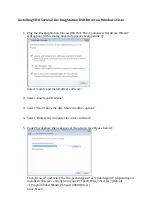
SECTION 1. PREPARATION AND SITING
1-7
Magnetic declination is bold in this example to
show its location in the table. A positive
declination is east, while a negative declination
is west. The declination in this example is
14.417 degrees. As shown in Figure 1.4-1, the
declination for Logan, UT is east, so True North
for this site is 360 - 14.417, or 345.5 degrees.
FIGURE 1.4-2. Declination Angles East of
True North Are Subtracted From 0 to Get
True North
FIGURE 1.4-3. Declination Angles West of True
North Are Added to 0 to Get
True North
References
1
EPA, (1987). On-Site Meteorological Program
Guidance for Regulatory Modeling Applications,
EPA-450/4-87-013. Office of Air Quality
Planning and Standards, Research Triangle
Park, North Carolina 27711.
2
WMO, (1983). Guide to Meteorological
Instruments and Methods of Observation.
World Meteorological Organization No. 8, 5th
edition, Geneva, Switzerland.
3
The State Climatologist, (1985) Publication of
the American Association of State
Climatologists: Height and Exposure Standards
for Sensors on Automated Weather Stations,
v. 9, No. 4 October, 1985.
4
EPA, (1989). Quality Assurance Handbook for
Air Pollution Measurement Systems, EPA Office
of Research and Development, Research
Triangle Park, North Carolina 27711.












































